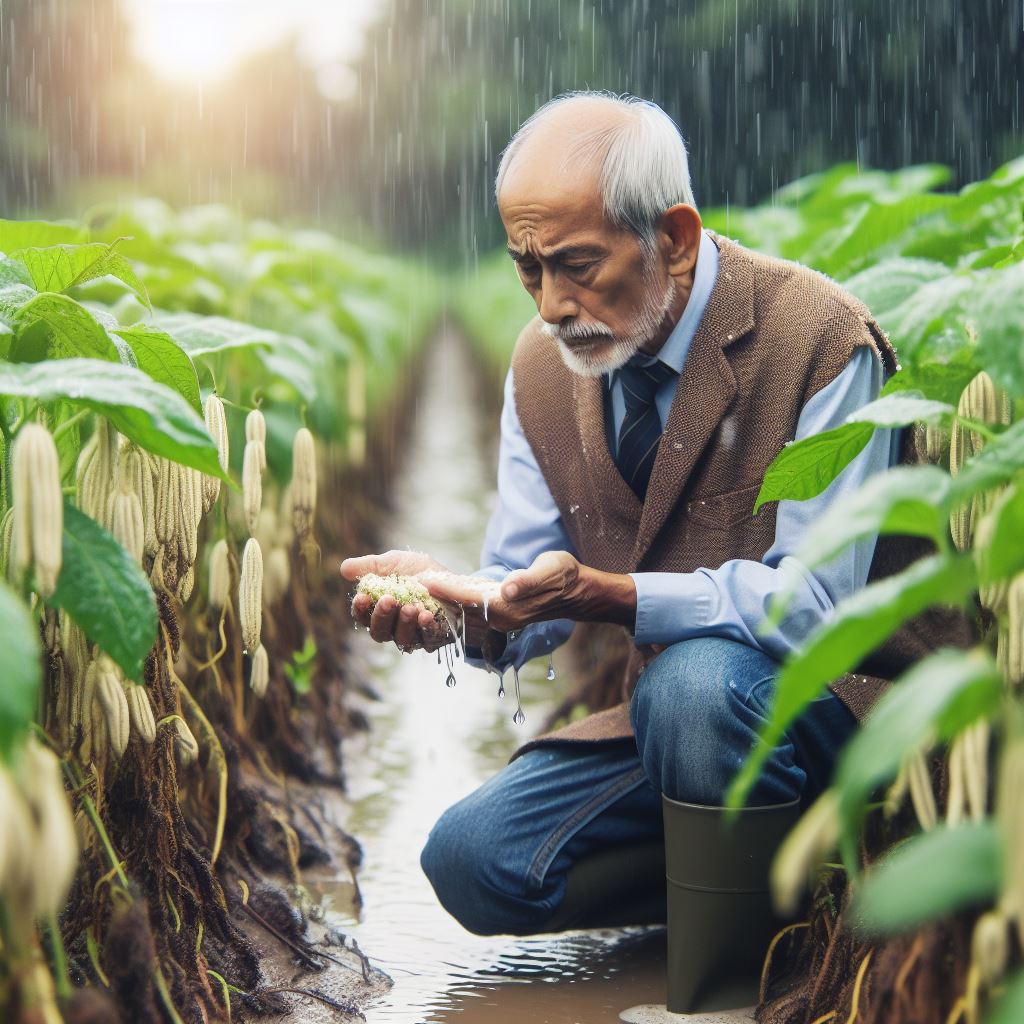Introduction
Addressing climate change in agriculture is of utmost importance as farmers face significant challenges due to its impacts.
Climate change presents a range of challenges for farmers as they strive to adapt their farming practices to new conditions.
Rising temperatures, erratic rainfall patterns, and extreme weather events are just a few of the issues they confront.
One of the primary concerns is how these changes affect crop yields.
Rising temperatures can reduce crop production by altering the timing of plant development and affecting crop pollination. This can lead to lower crop quality and decreased yields.
Changes in rainfall patterns also pose challenges for farmers.
Droughts and prolonged dry spells can seriously impact crop growth, leading to lower yields and even crop failure.
Conversely, intense rainfall events and flooding can damage crops, erode soil, and make fields unusable for long periods.
In addition to direct impacts on crops, changing climate conditions can increase the risk of pests and diseases.
Warmer temperatures can create more favorable conditions for pests, allowing them to multiply rapidly and damage crops.
Similarly, changes in precipitation patterns can favor the spread of certain diseases that thrive in moist environments.
To mitigate these challenges, farmers are adopting various strategies to adapt farming practices to a changing climate.
These include implementing irrigation systems, investing in drought-resistant crop varieties, practicing conservation agriculture, and using precision farming techniques.
Furthermore, farmers are also exploring innovative solutions such as vertical farming and hydroponics to ensure a more secure and sustainable food supply in the face of climate change.
In fact, addressing climate change in agriculture is crucial for ensuring food security and sustainable farming.
By adapting their practices, farmers can mitigate the challenges posed by changing climate conditions and continue to provide for growing populations.
Understanding the Impact of Climate Change on Crops
Relationship between climate change and agricultural productivity
Climate change affects agricultural productivity as weather patterns and climatic conditions change, resulting in various challenges for farmers.
Effects of rising temperatures, erratic weather patterns, and precipitation changes on crop growth
Rising temperatures have a direct impact on crop growth and yield. Shifting growing seasons distort the timing of planting and harvesting, affecting the entire crop cycle.
For example, crops that require cool temperatures for proper development and maturation can suffer from reduced yield and quality due to shorter cool periods.
Erratic weather patterns pose immense challenges for farmers.
Unpredictable rainfall patterns and extreme events, such as droughts and floods, disrupt normal crop growth and development.
Excessive rainfall can lead to waterlogging, affecting root development and nutrient uptake.
Conversely, droughts limit water availability, stunting crop growth and causing yield losses.
Moreover, climate change favors the proliferation of pests and diseases.
Warmer temperatures create favorable conditions for the reproduction and survival of pests, leading to increased infestations.
Additionally, certain diseases thrive in higher temperatures, spreading more rapidly and causing more significant damage to crops.
This forces farmers to invest more in pest management strategies, increasing production costs.
Extreme weather events pose a significant threat to crop productivity.
Hurricanes, storms, and hailstorms can physically damage crops and farmland.
High winds can lodge or flatten crops, reducing their overall yield potential.
Furthermore, excessive rainfall associated with these events can leach nutrients from the soil and promote the spread of diseases.
Heat stress, another consequence of climate change, negatively affects plant growth and productivity.
High temperatures reduce photosynthesis rates and interfere with the development of reproductive structures, leading to reduced fruit set and poor quality of harvested products.
Crop varieties sensitive to heat stress, such as vegetables and certain fruits, suffer the most.
Climate change also disrupts natural pollination processes.
Changes in rainfall patterns can affect pollinator activity and reduce the efficiency of pollen transfer, resulting in low fruit formation and reduced crop yields.
This is particularly critical for crops heavily dependent on pollinators, such as fruits, nuts, and oilseeds.
Bee populations, essential for crop pollination, are also susceptible to climate change impacts, further exacerbating the situation.
Transform Your Agribusiness
Unlock your farm's potential with expert advice tailored to your needs. Get actionable steps that drive real results.
Get StartedFrost damage is a significant concern for many crops, especially in regions experiencing shifting frost dates.
Changes in temperature patterns can expose crops to unexpected late frosts, causing severe damage and crop losses.
This can have devastating consequences for fruit trees and early-season vegetables.
Overall, climate change poses substantial challenges to the agricultural sector.
Farmers must not only adapt their practices but also find ways to mitigate the ongoing negative impacts to safeguard global food security.
Read: Agroforestry: A Climate Smart Approach
Adapting Traditional Farming Methods to Changing Climate
In this section, we will discuss the importance of adapting traditional farming methods to cope with the challenges posed by climate change.
Modifying farming practices
Farmers play a crucial role in maintaining food security and feeding the growing global population.
However, with climate change affecting weather patterns and increasing the frequency of extreme events, farmers must modify their practices to adapt to these changes.
Crop rotation
Crop rotation is a technique that involves growing different crops in a specific sequence on the same piece of land.
This practice helps improve soil fertility, reduces pest and disease pressures, and optimizes nutrient utilization.
By rotating crops, farmers can minimize the risk of crop failure due to climate-related factors.
Different crops have varying tolerance levels to heat, drought, or excessive rainfall, which allows for a more resilient system.
Intercropping
Intercropping, the practice of growing two or more different crops together in the same field, offers several benefits in terms of climate adaptation.
First, intercropping allows for better space utilization, maximizing land productivity and yield.
By mixing crops with different root structures and canopy heights, farmers can also reduce soil erosion and optimize water and nutrient uptake.
Additionally, in intercropped systems, if one crop fails due to adverse weather conditions, the other crops can still provide some yield, ensuring food production stability.
Agroforestry
Agroforestry is an integrated land use management system that combines trees or shrubs with crops or livestock production.
This practice promotes biodiversity, soil conservation, and climate resilience.
By incorporating trees into farming systems, farmers create microclimates that provide shade, windbreaks, and moisture regulation.
These trees also contribute to carbon sequestration, mitigating greenhouse gas emissions and combatting climate change.
Soil management and conservation
Proper soil management and conservation practices are essential for adapting to climate change.
Farmers should focus on improving soil health and resilience to withstand extreme weather events.
Implementing techniques such as cover cropping, mulching, and composting can enhance soil structure, water-holding capacity, and nutrient availability.
These practices also help reduce soil erosion, which is a significant concern in areas experiencing heavy rainfall or frequent droughts.
Conservation tillage, including reduced or no-tillage, further preserves soil structure and organic matter, reducing moisture loss and improving fertility.
Adapting traditional farming methods to changing climate conditions is crucial for farmers to ensure food security and sustainable agricultural practices.
By implementing techniques like crop rotation, intercropping, and agroforestry, farmers can improve their resilience to climate-related challenges and maintain stable crop production.
In addition, prioritizing proper soil management and conservation practices is essential for enhancing the soil’s ability to withstand extreme weather events and continue to support productive agriculture.
Ultimately, these adaptations will contribute to building a more resilient and sustainable agricultural system in the face of climate change.
Read: Future Foods: Climate-Resilient Crops

Utilizing New Technologies in Climate Adaptation
Technology plays a crucial role in assisting farmers in adapting to climate change.
It enables them to overcome the challenges posed by unpredictable weather patterns and shifting growing seasons.
Let’s explore some of the innovative techniques and tools that aid in climate adaptation:
Precision Farming Techniques
- Data-driven decision-making: Farmers can analyze data to make informed choices regarding crop selection, planting dates, and resource allocation.
- Sensor technologies: By using sensors, farmers can monitor soil moisture levels, temperature, humidity, and other variables in real-time.
These precision farming techniques enable farmers to optimize their agricultural practices and maximize crop yields while minimizing the impact of climate change.
Benefits of Utilizing Advanced Tools
Advanced tools offer various benefits for farmers in adapting to climate change:
- Irrigation: Advanced irrigation technologies, such as drip irrigation or precision sprinklers, minimize water wastage and ensure efficient water distribution to crops.
- Pest and Disease Management: Integrated Pest Management (IPM) systems utilize remote sensing, drones, and automated traps to monitor pests and diseases, enabling timely interventions.
- Weather Forecasting: Accurate weather forecasting helps farmers make timely decisions regarding planting, harvesting, and applying agrochemicals, reducing crop losses due to extreme weather events.
By leveraging advanced tools for irrigation, pest and disease management, and weather forecasting, farmers can mitigate climate risks and safeguard their harvests.
Showcase Your Farming Business
Publish your professional farming services profile on our blog for a one-time fee of $200 and reach a dedicated audience of farmers and agribusiness owners.
Publish Your ProfileMoreover, technology also extends to crop breeding and genetic engineering, aiding the development of climate-resistant crops.
Scientists are working on creating more drought-tolerant, heat-resistant, and disease-resistant varieties that can thrive in changing climatic conditions.
Additionally, technology has facilitated the establishment of digital platforms and mobile applications, connecting farmers with experts, agronomists, and markets.
These platforms provide farmers with access to real-time information on weather updates, market prices, and best agricultural practices, thereby empowering them to make informed decisions.
Technology has revolutionized the agricultural sector, equipping farmers with indispensable tools for climate adaptation.
Through precision farming techniques, advanced tools for irrigation, pest and disease management, weather forecasting, as well as genetic engineering and digital platforms, farmers can navigate the challenges posed by climate change and ensure sustainable agricultural practices.
Read: Soil Conservation Techniques in Drought
Policy and Collaboration for Climate-Resilient Agriculture
In order to promote climate resilience in agriculture, supportive policies and government initiatives play a crucial role.
These policies serve as essential frameworks that guide farmers and stakeholders towards sustainable farming practices.
One significant impact of supportive policies and government initiatives is the encouragement of sustainable farming practices.
Governments often provide incentives and subsidies to farmers who adopt climate-smart techniques, such as organic farming and agroforestry.
These initiatives aim to reduce greenhouse gas emissions, conserve water resources, and protect biodiversity.
Successful governmental programs have paved the way for sustainable agriculture.
For instance, in countries like the United States and Canada, the implementation of conservation programs has helped farmers adopt practices that promote soil health and reduce erosion.
These programs support the development and maintenance of crop rotations, cover cropping, and minimal tillage techniques, which in turn enhance the overall resilience of farming systems to climate change.
Moreover, the establishment of farmer-led organizations has emerged as a valuable initiative in promoting sustainable agriculture.
These organizations provide platforms for farmers to exchange knowledge, share experiences, and collectively address climate change challenges.
By working together, farmers can adapt to changing climate conditions more effectively, ensuring the continued productivity of their farms while mitigating potential risks.
Collaboration among different stakeholders is crucial in addressing climate change challenges.
Researchers, farmers, and policymakers must work together to develop solutions that are practical, effective, and adaptable to local contexts.
Through collaborative efforts, stakeholders can identify region-specific challenges and develop tailored strategies to overcome them.
Policymakers play a vital role in facilitating collaboration and ensuring the implementation of climate-resilient agricultural practices.
They need to prioritize the allocation of resources and funding for research programs that focus on developing climate-smart technologies and practices.
By regularly consulting with farmers and researchers, policymakers can create policies that address the specific needs and challenges faced by the agricultural community.
Furthermore, international collaborations are highly valuable in promoting climate-resilient agriculture.
Countries can share best practices and experiences, exchange technological advancements, and jointly address common agricultural challenges resulting from climate change.
Such collaborations foster learning and innovation, allowing for the development of effective strategies that can be implemented on a global scale.
In short, supportive policies and government initiatives are integral to promoting climate resilience in agriculture.
Successful governmental programs and incentives encourage farmers to adopt sustainable farming practices, while collaboration among stakeholders ensures a comprehensive and well-rounded approach to addressing climate change challenges.
It is through collective efforts and policy implementation that the agricultural sector can adapt and thrive despite the changing climate conditions.
Read: Drought-Resilient Crops: A Guide
Conclusion
To conclude, it is evident that climate change poses significant challenges to agricultural practices around the world.
Farmers need to adopt measures that adapt to a changing climate to ensure food security and sustainability.
Urgent actions are required to implement climate-resilient farming approaches.
In summary, this blog post highlighted the impacts of climate change on crops, such as reduced yields and increased susceptibility to pests and diseases.
We discussed innovative techniques like precision agriculture, crop diversification, and water management to overcome these challenges.
It is crucial to acknowledge the pressing need for farmers and policymakers to prioritize sustainable agriculture initiatives.
By implementing climate-resilient farming approaches, we can minimize the negative effects of climate change on crops and improve the resilience of our food systems.
Therefore, this post emphasizes the importance of exploring and adopting climate-resilient farming practices.
It encourages farmers and readers to support sustainable agriculture initiatives, promote innovative techniques, and invest in research and development to meet the challenges of a changing climate.
In review, by taking immediate actions to adapt farming practices, we can work towards a more sustainable future, ensure food security, and mitigate the adverse effects of climate change on agricultural systems.
Let us all contribute to a resilient and environmentally conscious farming sector.




